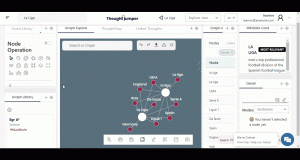Knowledge graphs are very powerful; and can significantly change the way an organisation runs. In this blog we intend to cover some of the questions that ponder on the relevancy and maturity of an organisation to knowledge ready and knowledge aware.
There are several questions that need to be answered to reach a meaning conclusion; while we have identified some; we will focus on the top 2 in this blog.
- How can Knowledge Graphs help my organisation?
- When do you know that you need a knowledge graph?
- Is my organisation ready for a knowledge graph implementation?
- Who should be involved in the knowledge graph discussion?
- Why develop a knowledge graph in an agile way?
However, before jump deeper into those let us first try and answer – What is knowledge?
What is Knowledge?
According to Wikipedia –
Knowledge is a familiarity or awareness, of someone or something, such as facts (descriptive knowledge), skills (procedural knowledge), or objects (acquaintance knowledge), often contributing to understanding.
By most accounts, knowledge can be produced in many different ways and from many sources, including but not limited to perception, reason, memory, testimony, scientific inquiry, education, and practice.
The term “knowledge” can refer to a theoretical or practical understanding of a subject.
It can be implicit (as with practical skill or expertise) or explicit (as with the theoretical understanding of a subject); formal or informal; systematic or particular.
What is a Knowledge Graph?
According to Wikipedia –
In knowledge representation and reasoning, knowledge graph is a knowledge base that uses a graph-structured data model or topology to integrate data.
Knowledge graphs are often used to store interlinked descriptions of entities – objects, events, situations or abstract concepts – while also encoding the semantics underlying the used terminology.
Since the development of the Semantic Web, knowledge graphs are often associated with linked open data projects, focusing on the connections between concepts and entities.
They are also prominently associated with and used by search engines such as Google, Bing, and Yahoo; knowledge-engines and question-answering services such as WolframAlpha, Apple’s Siri, and Amazon Alexa; and social networks such as LinkedIn and Facebook.
For more, we urge you to check our blog at – https://thoughtjumper.com/knowledge-graphs-primer/
How can Knowledge Graphs help my organisation?
Becoming a Knowledge Organisation, is a long road ahead; but with a promising future that isn’t just a promise but path to learning, awareness, cross-pollination and growth. Building a knowledge graph isn’t like introducing just any new technology. It demands hard work and persistence.
Knowledge graph could be one of the biggest asset for the organization and hence it requires an initiative of change, that is aligned with careful planning of goals and strategies with agile intervention. It needs careful consideration, deliberation, debates that lead to confluence of:
A. People & Processes
- standardising processes
- honing new skills in people
- think in abstracts, data and metrics
- redefining the learning culture
B. Technology and its substratum
- tailoring implementations
- engineering bridges between data silos
- building common vocabularies, metadata
- defining ontologies, dictionaries & categories of information
- piping data from several applications
C. Business & Strategy
- defining long term and short term strategies
- mapping goals; quantitatively and qualitatively
- defining values of exchange
- aligning business with productivity, change and growth
When do you know that you need a knowledge graph?
A. Data in silos, means opinions in silos, leading to lack of consensus or commonly adopted strategy
You often want to get information out of your systems but you do not succeed because
- there are so many systems but they do not talk to each other, each have their own different data models and you need help to translate between them and find meanings
- you need experts to help wrangle the answers out of your systems
- even your experts have divided opinions and do not often reach a common understanding
B. There is repetition, rework, and too much external reliance
You often can’t identify the right person or expert in your company, so you have to start from scratch
- After you have completed a project or work, you have often found that something similar already existed.
- You always use Google instead of internal tools to find things.
- You often find decentralised and disintegrated processes are counter-beneficial than hyper-localised and optimised.
C. Misinformation is often a result of misunderstanding and lack of exposure
You often face the problem of having to translate or rephrase your questions across languages, because you work in a cross-cultural cross-domain setup and the pace at which the organisation functions is not so uniform as we think it to be.
- your departments have different views on things
- your partners have their own language and processes
- the language and technology keeps evolving and this evolution of change needs to be taken into account
To be continued…


